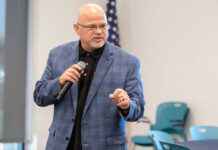
On Oct. 19, the Board of Supervisors heard several proposed major amendments to the 2009 Pinal County Comprehensive Plan. The comprehensive plan is the county’s guidebook for sensible, sustainable growth — acknowledging that the growth will return but some factors, such as the availability of water, are limiting factors.
The most significant of the proposed amendments came from the Arizona State Land Department (ASLD). It called for changes in the plan for the 275 square mile area north of Florence called Superstition Vistas.
Long-range planning for communities that will one day occupy an area of 275 square miles has generated a mixture of excitement, skepticism, cautious optimism and opposition. One of the critical questions has been: Why is the State Land Department doing this now?
In the newly revised comprehensive plan, there are areas — particularly state lands north of U.S. 60 and east of State Route 79 – that are shown as open space or preserve. Why does the proposed amendment show them as medium density (1 to 3.5 dwelling units per acre)? Why do we have to plan such a large area in this kind of detail all at once?
More questions: The Magma Rail line (running between the copper mine in Superior to the Union Pacific rail line near Coolidge) has a buffer zone of industrial and employment activity centers on both sides of it in the current comprehensive plan. So why does the State Land proposal replace the middle part of the line with residential uses instead of retaining employment and industrial uses?
To be sure, the approach used by ASLD and members of the Superstition Vistas Committee is innovative. They first identified drainage ways, transportation corridors, and wildlife corridors before moving on to the usual planning components of residential housing, retail and employment centers, etc. And the concept of laying out a plan for the entire area — as opposed to developing the area little piece by little piece — is elegant. However, there is one persistent fly in the SV concept in my opinion: water, or rather the lack thereof.
Most of the vistas land is scrub desert. From the air, pretty much all you can see is open desert. The small areas that were once farmed are few and mostly on the western edge of the vistas. That’s because the underground (or groundwater) supply is near zero or nonexistent. If there were supplies of groundwater, the area would certainly have been farmed in the past.
Why am I concerned about water supplies for the vistas’ development? A built-out Superstition Vistas is estimated to house at least one million residents and they will require some 175,000 acre feet of “real, wet” water annually. That’s a lot of water in anyone’s book.
Representatives from the Superstition Vistas Committee and those supportive of the project have been attempting to reassure Pinal County the water issues will resolve themselves as time passes. Those who are skeptical of the vistas’ densities and demand for water characterize the SV plan as a “build it and we’ll find the water later” approach to development.
So the critical challenges facing the development are:
- Where can developers find and acquire wet water (read accessible, reliable) supplies.
- What will the cost be to the end-users in SV (in other words, what will the extra charge be to the home buyer).
- How will they transport those supplies (on a regular, routine basis) to SV’s residents.
- How (and where) will the ultimate developers of SV acquire supplies of renewable water to satisfy the Assured Water Supply requirements of Arizona’s 1980 Groundwater Management Act?
When the SV plan amendment came before us, I voted “no” on a motion to remand the proposed SV amendment back to the County’s Planning Commission — not because I thought sending it back was inappropriate but because of my concerns about the water issues. It should be noted here that I did (and do) appreciate the fact that the ASLD worked to reach compromises with several concerned groups on issues related to dwelling densities north of US 60 as well as the issue of what kinds of land uses should be indicated in the Magma Rail Line corridor.
Nonetheless, my vote in opposition was squarely focused on the issue of water supplies. Although proponents of the Vistas project have been quick to point out that they are calling for the deployment of green, water-conserving technologies and practices that will reuse and reclaim water – there will first need to be wet water delivered to those lands. You can’t conserve or reuse what you don’t have to start with.
Shortly after the Oct. 19 board meeting, I went to ASLD to propose a water supply plan that suggested some ways for the Department to bring some water to the SV area and recharge those supplies in advance of future development.
My proposal was not intended to address the long-term water supply needs of a built-out SV but rather to show that there might be a way for those who would develop SV or serve the residents of SV (i.e. water utilities that already service residential and commercial customers in developments immediately adjacent to the SV area). If those recharge efforts were underway in the next couple of years, a reasonable bank of “starter” water supplies could be accumulated.
I also have a personal “dog in this fight.” In the mid-1980s the city of Mesa bought 11,000 acres of farm land in the Coolidge-Eloy area for the purpose of creating a “water farm” (i.e. retiring the water rights to the land and then using that water for the purpose of an Assured Water Supply per the 1980 Groundwater Management Act. I and others have been on guard for other attempts to move water from the Pinal Active Management Area to other areas of the state. In fact, we were successful in passing state legislation that prohibits the movement of groundwater supplies from basins to basins or from our AMA to other AMAs.
Why is this a concern? First of all, although the Pinal AMA has some significant groundwater supplies in storage, there are less than 100,000 acre feet of renewable water supplies allocated to various public and private utilities in the AMA. Remember “water flows uphill to money.” Legislation can be changed or set aside and if there’s enough money involved, water rights can be purchased and the water moved to consumers elsewhere.
If SV can find enough wet and renewable water — from somewhere other than the Pinal AMA — and they successfully address the other issues of density and land uses adjacent to the Magma Rail corridor, I will consider their proposed amendment in a more positive light.
Supervisor David Snider (D-Casa Grande) represents Maricopa and District 3 on the Pinal County Board of Supervisors.









![Maricopa restaurateur makes Food Network connection [Namkeen Dhaba]](https://www.inmaricopa.com/wp-content/uploads/2024/04/439456716_377105198650519_7536248579664805896_n-218x150.jpg)
![City gave new manager big low-interest home loan City Manager Ben Bitter speaks during a Chamber of Commerce event at Global Water Resources on April 11, 2024. Bitter discussed the current state of economic development in Maricopa, as well as hinting at lowering property tax rates again. [Monica D. Spencer]](https://www.inmaricopa.com/wp-content/uploads/2024/04/spencer-041124-ben-bitter-chamber-property-taxes-web-218x150.jpg)



![O’Reilly gears up for second Maricopa location An exterior view of O'Reilly Auto Parts on John Wayne Parkway on May 2, 2024.[Monica D. Spencer]](https://www.inmaricopa.com/wp-content/uploads/2024/05/spencer-050224-oreilly-second-location-web-100x70.jpg)
![Province writer opens the athlete’s mind in new book Tom Schuman, a Province resident, poses with a copy of his new book, "My Wide World of Sports," outside his home on May 2, 2024. [Monica D. Spencer]](https://www.inmaricopa.com/wp-content/uploads/2024/05/spencer-050224-tom-schuman-sports-book-web-01-100x70.jpg)